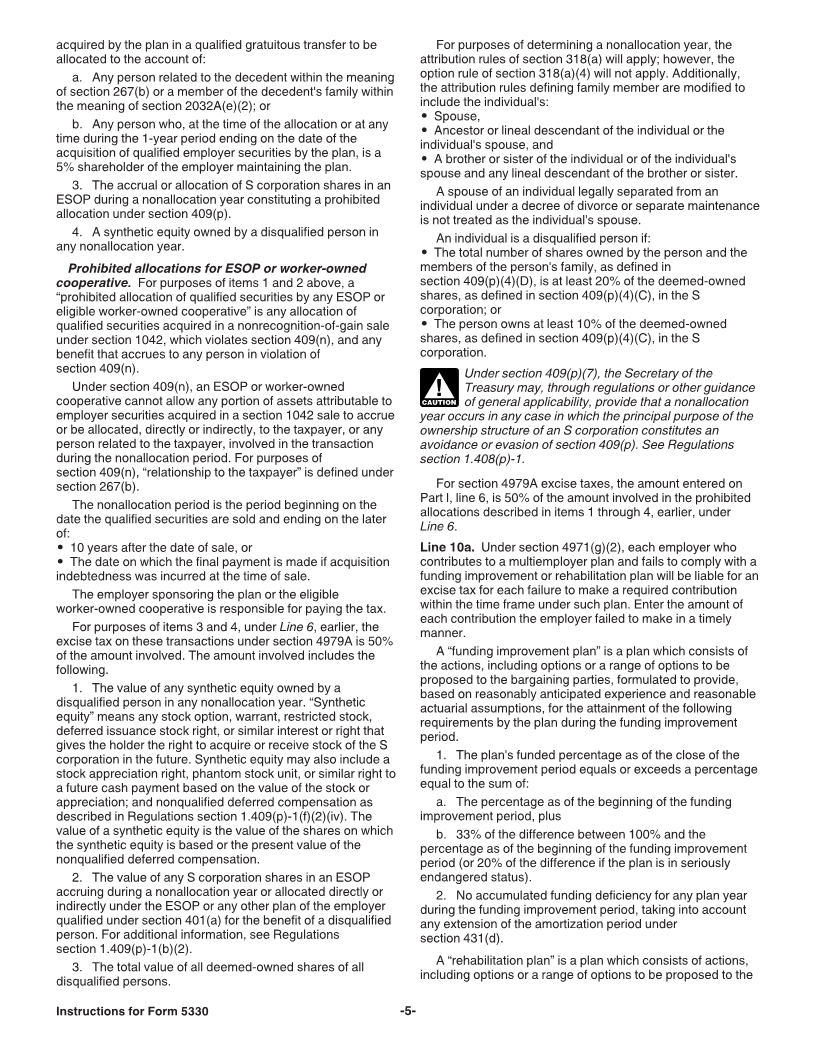
Enlarge image
Userid: CPM Schema: Leadpct: 100% Pt. size: 9.5 Draft Ok to Print
instrx
AH XSL/XML Fileid: … ns/i5330/202212/a/xml/cycle03/source (Init. & Date) _______
Page 1 of 14 18:53 - 20-Dec-2022
The type and rule above prints on all proofs including departmental reproduction proofs. MUST be removed before printing.
Department of the Treasury
Internal Revenue Service
Instructions for Form 5330
(Rev. December 2022)
Return of Excise Taxes Related to Employee Benefit Plans
Section references are to the Internal Revenue Code unless 1. A plan entity manager of a tax-exempt entity who
otherwise noted. approves, or otherwise causes the entity to be party to, a
prohibited tax shelter transaction during the tax year and
Future Developments knows or has reason to know the transaction is a prohibited
tax shelter transaction under section 4965(a)(2).
For the latest information about developments related to 2. An employer liable for the tax under section 4971 for
Form 5330 and its instructions, such as legislation enacted failure to meet the minimum funding standards under
after they were published, go to IRS.gov/Form5330. section 412.
3. An employer liable for the tax under section 4971(f) for
What’s New a failure to meet the liquidity requirement of section 430(j) (or
section 412(m)(5) as it existed prior to amendment by the
New Schedule L. Form 5330 has been updated to add a Pension Protection Act of 2006 (PPA '06)), for plans with
new Schedule L for a cooperative and small employer charity delayed effective dates under PPA '06.
(CSEC) plan sponsor to report tax on failure to adopt a
4. An employer with respect to a multiemployer plan
funding restoration plan if the plan is in funding restoration
liable for the tax under section 4971(g)(2) for failure to
status for a plan year (section 4971(h)).
comply with a funding improvement or rehabilitation plan
under section 432.
Reminders 5. An employer with respect to a multiemployer plan
Electronic filing. Electronic filing (e-filing) is available for liable for the tax under section 4971(g)(3) for failure to meet
Form 5330. The IRS Modernized e-File (MeF) System is the requirements for plans in endangered or critical status
used to file through an IRS Authorized e-File Provider. under section 432.
6. A multiemployer plan sponsor liable for the tax under
section 4971(g)(4) for failure to adopt a rehabilitation plan
General Instructions within the time required under section 432.
Purpose of Form 7. A CSEC plan sponsor liable for the tax under
section 4971(h) for failure to adopt a funding restoration plan
File Form 5330 to report the tax on:
within the time required under section 433(j)(3).
• A prohibited tax shelter transaction (section 4965(a)(2));
• A minimum funding deficiency (section 4971(a) and (b)); 8. An employer liable for the tax under section 4972 for
• A failure to pay liquidity shortfall (section 4971(f)); nondeductible contributions to qualified plans.
• A failure to comply with a funding improvement or 9. An individual liable for the tax under section 4973(a)(3)
rehabilitation plan (section 4971(g)(2)); because an excess contribution to a section 403(b)(7)(A)
• A failure to meet requirements for plans in endangered or custodial account was made for them and that excess has
critical status (section 4971(g)(3)); not been eliminated, as specified in sections 4973(c)(2)(A)
• A failure to adopt rehabilitation plan (section 4971(g)(4)); and (B).
• A failure to adopt funding restoration plan 10. A disqualified person liable for the tax under
(section 4971(h)); section 4975 for participating in a prohibited transaction
• Nondeductible contributions to qualified plans (other than a fiduciary acting only as such), or an individual or
(section 4972); the individual’s beneficiary who engages in a prohibited
• Excess contributions to a section 403(b)(7)(A) custodial transaction with respect to the individual’s retirement
account (section 4973(a)(3)); account, unless section 408(e)(2)(A) or section 408(e)(4)
• A prohibited transaction (section 4975); applies, for each tax year or part of a tax year in the taxable
• A disqualified benefit provided by funded welfare plans period applicable to such prohibited transaction.
(section 4976);
• Excess fringe benefits (section 4977); 11. An employer liable for the tax under section 4976 for
• Certain employee stock ownership plan (ESOP) maintaining a funded welfare benefit plan that provides a
dispositions (section 4978); disqualified benefit during any tax year.
• Excess contributions to plans with cash or deferred 12. An employer who pays excess fringe benefits and has
arrangements (section 4979); elected to be taxed under section 4977 on such payments.
• Certain prohibited allocations of qualified securities by an 13. An employer or worker-owned cooperative, as defined
ESOP (section 4979A); in section 1042(c)(2), that maintains an employee stock
• Reversions of qualified plan assets to employers ownership plan (ESOP) that disposes of the qualified
(section 4980); and securities, as defined in section 1042(c)(1), within the
• A failure of an applicable plan reducing future benefit specified 3-year period (see section 4978).
accruals to satisfy notice requirements (section 4980F). 14. An employer liable for the tax under section 4979 on
excess contributions to plans with a cash or deferred
Who Must File
arrangement, etc.
A Form 5330 must be filed by any of the following.
Dec 20, 2022 Cat. No. 11871X












